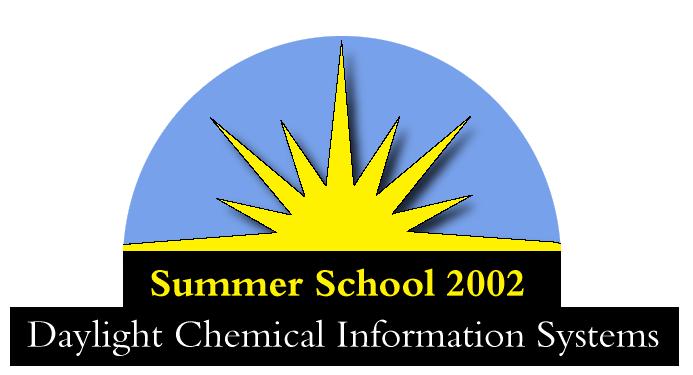SMARTS, An Introduction

SMARTS, An Introduction |  |
| SMARTS | Hits SMILES: | Note | |||
|---|---|---|---|---|---|
[+2] |
Atoms that have a plus two charge. | All SMILES atomic properties are valid in SMARTS; this includes charge, hydrogen count, isotopic specifications, bond symbols, and chirality specification. | |||
[a] |
Atoms that are aromatic | "a" is any aromatc atom. | |||
[A] |
Atoms that are aliphatic. | "A" is any aliphatic atom. | |||
[#6] |
Atoms that have an atomic number of 6 (c or C). | "#<number>" defines an atom that has an atomic number of <number>. Hits both aliphatic and aromatic atoms. | |||
[R2] |
Atoms that are in 2 SSSR (smallest set of smallest rings). | "R<number>" defines an atom that is in <number> smallest rings. Default (R) is any ring atom. | |||
[r5] |
Atoms that are in an SSSR ring that has 5 members. | "r<number>" defines an atom that is an SSSR ring that has <number> rings. Default (r) is any ring atom. | |||
[v4] |
Atoms that have four bonds. | "v<number>" defines an atom that has <number> bonds. Total bond order (= is 2 bonds, # is 3) |
|||
[X2] |
Atoms that are connected to two other atoms. | X<number> defines an atom that is connected to <number> other atoms | |||
[H1] |
Atoms that have one attached hydrogen. | H<number> defines an atom that has <number> attached hydrogens. | |||
[H] |
Hydrogen Atoms | A hydrogen atom has special properties ([H+],[2H], [H][H] etc.) | |||
CC |
Molecules where an aliphatic carbon is SINGLE BONDED (implicitly) to another aliphatic carbon. | All SMILES bond properties are valid in SMARTS; this includes implicit single bonds, explicit single bonds (-), double bonds (=), tripple bonds (#), and aromatic bonds (:). WON'T match double bonds or tripple bonds (includes C=C and C#C ...). | |||
[#6]~[#6] |
Molecules where two carbons are connected by any bond (includes single bonds, double bonds, tripple bonds, and aromatic bonds). | "~" means any bond (wildcard bond). | |||
[#6]@[#6] |
Molecules where two carbons are connected by a ring bond. | "@" is a bond between two atoms that are within the same ring. | |||
F/?[#6]=C/Cl |
Molecules where (a carbon and a fluorine which are connected by a directional bond which is "up or unspecified") is connected to another carbon (which is connected by an "up" bond to a chlorine) (e.g. F/C=C/Cl and FC=C/Cl ). This excludes molecules where (a carbon and a fluorine which are connected by a down bond) is connected to another carbon (which is connected to a chlorine by an "up" bond) | "?" means "OR unspecified". "?" may also be used with chirality specification (@ and @@). | |||
[!c] |
Atoms that are NOT aromatic carbons. | "!" means "not". | |||
[N,#8] |
Atoms that are an aliphatic Nitrogen OR an Oxygen (aromatic or aliphatic) | "," means OR. OR is higher precedence than low precedence "and", but lower precedence than high precedence "and". | |||
[N,#6&+1,+0] |
Atoms that (are aliphatic Nitrogens) or (are positively charged carbons) or (are neutral) | "&" is "and" (high precedence). | |||
[12*+0,H2] |
Atoms that (have a mass of 12 AND are neutral) OR ( have 2 hydrogens). | All smiles atomic properties are valid in SMARTS. High precedence "and" is the default logical operator. | |||
[N,#6;+0,+1] |
Atoms that (are aliphatic Nitrogens or are carbons) AND (are neutral or positively charged) | ";" is "and" (low precedence). | |||
[$(*O);$(*CC)] |
Atoms that are in an environment where (the atom is connected to an aliphatic oxygen) and where (the atom is connected to two sequential aliphatic carbons) | Any SMARTS expression may be used to define an atomic environment by writing a SMARTS starting with the atom of interest in this form: $(<SMARTS>) | |||
[#6][$(aaO);$(aaaN)] |
Molecules where a carbon is ortho to an O and meta to an N. | ||||
[$([CX3]=[OX1]), |
Atoms that are within molecules which contain a Carbonyl group (either resonance structure). | ||||
[#8].[#8] |
Molecules that contain two oxygens ( e.g. O=O, OCCO and O.CCO) | "." (dot) in SMARTS means "not necessarily connected". | |||
([#8].[#8]) |
Molecules that contain two oxygens that are within the same component ( e.g. O=O and OCCO but NOT O.CCO) | A single set of parentheses may surround any legal SMARTS expression. Here parenthesis indicate that the contents are within the same component of the target SMILES. | |||
([+].[-]) |
Zwitterions | ||||
([#8]).([#8]) |
Molecules or mixtures that contain two oxygens that are within different components ( e.g. O.CCO but NOT O=O or OCCO) | Separate Component-Level Groupings may be specified. Here parenthesis indicate that the respective contents are within different components of the target SMILES. | |||
([+]).([-]) |
Salts | ||||